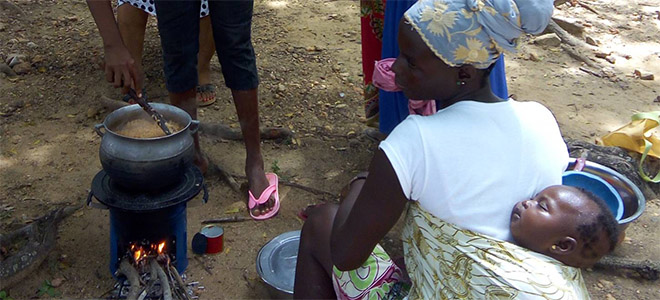
CSTPR research examines human behavior and cookstove use in West Africa
CIRES News
December 29, 2016
Close to half the world’s population cooks over an open fire every day. That’s hard on human health—people cooking over an open fire breathe in smoke and gases that can damage their lungs. Burning biomass is also bad for the environment, contributing to poor air quality and the production of black carbon, as well as deforestation. Making the transition to cleaner cooking practices is a process that intrigues Katie Dickinson, a research scientist with CIRES and the Center for Science and Technology Policy Research at CU Boulder, and a project scientist at the National Center for Atmospheric Research. Part of Dickinson’s work explores how people in the developing world make this shift, and she’s spent the past few years traveling back and forth to West Africa, to study the use of cookstoves in northern Ghana.
The question of what drives human behavior is one of the basic questions at the center of Dickinson’s research. “Our first project, which was from 2013 to 2016, studied 200 households in rural northern Ghana,” says Dickinson. “We gave them two different types of cookstoves and analyzed how much they liked them, and used them, and whether they prefered them to traditional cooking methods.” They found that while the participants liked the stoves and used them regularly, lowering exposure to some pollutants, most of the households also continued to cook over open fires. But their research does suggest that people in developing nations could see benefits to their health by using these improved cooking stoves. “Now,” says Dickinson, “What we want to do is see what some of the barriers are to adoption of these stoves.”
Her next project, which is just starting, is called “Prices, Peers and Perceptions: Improved Cookstove Research in Ghana.” Her team, which is working in close conjunction with the Navrongo Health Research Center, part of the Ghana Health Service, has funding from the National Science Foundation and other sources to understand why people choose to adopt new technology. And this project will also expand beyond just rural areas, where wood, crop residue and charcoal are the main fuel sources, to urban areas, where residents use charcoal and liquified petroleum gas.
She and her team will be studying three variables in particular: Price—how variations in the amount households are asked to pay for a stove affects whether people want or use these products; peers—whether having a neighbor with a stove influences purchase and use; and perceptions—how both the prices and the exposure to the new stoves via peers affect people’s perceptions of those stoves. “There are lots of dynamics between these three elements. We want to know what all three say about whether someone wants a new stove and if they stop using the old one,” explains Dickinson. Read more …


What’s Cooking in Ghana?
CSTPR research examines human behavior and cookstove use in West Africa
CIRES News
December 29, 2016
Close to half the world’s population cooks over an open fire every day. That’s hard on human health—people cooking over an open fire breathe in smoke and gases that can damage their lungs. Burning biomass is also bad for the environment, contributing to poor air quality and the production of black carbon, as well as deforestation. Making the transition to cleaner cooking practices is a process that intrigues Katie Dickinson, a research scientist with CIRES and the Center for Science and Technology Policy Research at CU Boulder, and a project scientist at the National Center for Atmospheric Research. Part of Dickinson’s work explores how people in the developing world make this shift, and she’s spent the past few years traveling back and forth to West Africa, to study the use of cookstoves in northern Ghana.
The question of what drives human behavior is one of the basic questions at the center of Dickinson’s research. “Our first project, which was from 2013 to 2016, studied 200 households in rural northern Ghana,” says Dickinson. “We gave them two different types of cookstoves and analyzed how much they liked them, and used them, and whether they prefered them to traditional cooking methods.” They found that while the participants liked the stoves and used them regularly, lowering exposure to some pollutants, most of the households also continued to cook over open fires. But their research does suggest that people in developing nations could see benefits to their health by using these improved cooking stoves. “Now,” says Dickinson, “What we want to do is see what some of the barriers are to adoption of these stoves.”
Her next project, which is just starting, is called “Prices, Peers and Perceptions: Improved Cookstove Research in Ghana.” Her team, which is working in close conjunction with the Navrongo Health Research Center, part of the Ghana Health Service, has funding from the National Science Foundation and other sources to understand why people choose to adopt new technology. And this project will also expand beyond just rural areas, where wood, crop residue and charcoal are the main fuel sources, to urban areas, where residents use charcoal and liquified petroleum gas.
She and her team will be studying three variables in particular: Price—how variations in the amount households are asked to pay for a stove affects whether people want or use these products; peers—whether having a neighbor with a stove influences purchase and use; and perceptions—how both the prices and the exposure to the new stoves via peers affect people’s perceptions of those stoves. “There are lots of dynamics between these three elements. We want to know what all three say about whether someone wants a new stove and if they stop using the old one,” explains Dickinson. Read more …